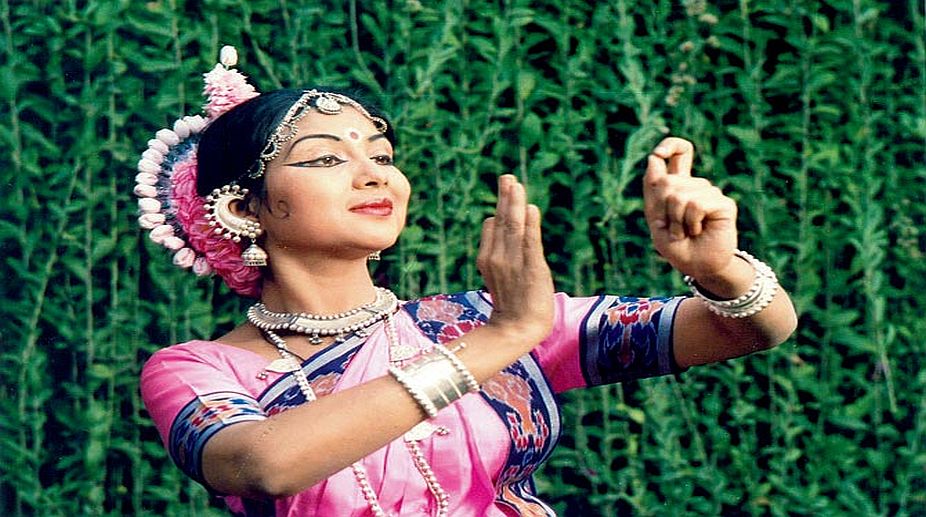Heritage bookstore in College St set to open new outlet
Dasgupta, the well-known heritage bookstore in the city, is going to open its outlet in south Kolkata on 1 May.

Aloka Kanungo (TWITTER)
Though a daughter of Odisha, Sangeet Natak Akademi awardee Aloka Kanungo’s adopted home is Kolkata. She is an Odissi exponent, who teaches, performs, writes and researches in order to extend the boundaries of her genre. A purist, she has no penchant for diluting the art form, which she has imbibed from her mentor, the legendary multi-faceted genius, Guru Kelucharan Mohapatra.
Armed with a senior fellowship from the Union ministry of culture, she has been into serious research on Bandha Nritya since 1995, which has given her a vision that has in many ways found reflection in her work. Inspired by the Manmatha Nauka Chitra Bandha, she has choreographed Mana Samhara that has been embellished with many bandha or acrobatic postures. The grammar of acrobatic postures as practised by the Gotipuas has been rigorously inculcated in her disciples.
That was evident in the spectacular performances presented in her institution, Shinjan Nrityalaya’s grand annual programme at Rabindra Sadan, Kolkata. Debasee Sen and Srinithi Mitra stood out as good dancers in Mana Samahar — a wonderful musical composition by Guru Ramahari Das. It consisted of a garland of tihais or three-time repetition of a bol (tihais are known as mana in Odiya). Bhaunri mana and Lagana mana were extensively used in the composition. The piece was set to raag Shankarabharana and aditaal of 16 beats. It was a challenging piece and Kanungo, the choreographer, was at her best in it giving a fresh dimension to time and space. The dancers formed a kaleidoscope of different shapes and designs and covered the stage with the varied and typical stances that Odissi is known for while bending the body in tribhangi or the threebend postures. The tihais or the manas were finely woven as in a Pallavi — a creative innovation while meandering through the lanes of tradition. The eight performers danced with élan.
Advertisement
The final and last item of the evening’s presentation at Rabindra Sadan was a Prabandha Geeta — it was again another topic of Kanungo’s research. The Prabandha Geeta possesses four limbs— biruda- sabda, pata-taal, tenaka – nam tom like the swara- sapta swara of music. This Prabandha Geeta by Gopinath was on the ten incarnations of Lord Vishnu. Each avatar was first enacted with music followed by the song in Odiya describing their story. Among all the avatars, Narasimha, Bamana, Parshuram and Rama were excellently delineated.
Apart from showcasing dances based on her research work, Kanungo presented her students in a number of other pieces too.
The programme started with an invocatory item Nama Ganesh, a customary tribute to the elephant-headed God who removes all obstacles. The music composition was by legendary sitar maestro Deepak Choudhury and it was set to a seven beat rhythm in different intricate configuration. The junior students standing on either side holding lamps resembled temple sculptures.
Rangagapuja or the customary worship of the stage was the next piece. A handful of dancers paid tribute to the ten directions and their custodian deities such as Eishan, the invisible power that governs the universe; Indra, the god of heaven; Agni, the god of fire; Yama, god of death; Nairuta, the god of the demons; Kubera, the god of wealth; Vayu, the wind god; Varuna, the god of water; Brahma, the creator and Vishnu, the preserver. The dancers did justice to the choreography. Indian mythology is a storehouse of such stories, just waiting for creative minds to make aesthetic presentations on. The symbolism of the directions represented by the deities would perhaps be the subject matter of Kanungo’s next choreography.
Not satisfied with the threefold objective of practising, propagating, and preserving Odissi dance in its purest form, Kanungo has quite a few other projects up her sleeve like following the guru-shishya parampara to its last detail. Her students receive training in such a way that it is a lifelong commitment to their learnt form. Her students have branched out individually and are recipients of scholarships that would equip them to take up dance as their profession. The institution has grown from strength to strength from the time of its inception in 1996.
For the students of Shinjan, dance is a way of life. Kanungo constantly trains them to do everything connected with dance. They do administrative work, besides helping in making costumes, stage decor and looking after other details. They organise their own festivals, seminars and workshops and the repertory members of Shinjan are always invited for prestigious festivals all over the country. Kanungo said that her troupe’s performances at Khajuraho, Konark, Nisagandhi and Kalakshetra festivals of dance are still fresh in the mind of spectators. Under her able guidance, Shinjan Nrityalaya boasts a large number of gifted and graceful dancers, who are the proud recipients of scholarships and fellowships.
Kanungo’s worthy disciples Atreyi Majumdar, Baishali Kolay, Nivedita Daw, Sriparna Bose and Sampa Banerjee have all been awarded the national scholarship with fellowship holder, Arpita Venkatesh making them a perfect team.
Advertisement